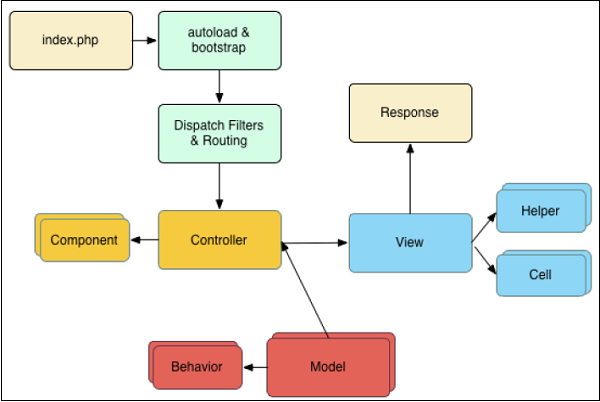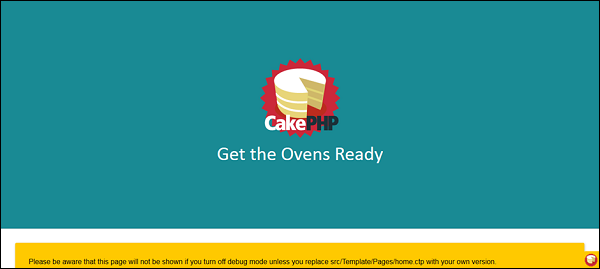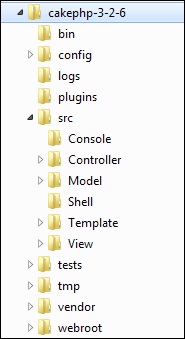CakePHP - Overview
CakePHP is an open source MVC framework. It makes developing, deploying and maintaining applications much easier. CakePHP has number of libraries to reduce the overload of most common tasks. Following are the advantages of using CakePHP.- Open Source
- MVC Framework
- Templating Engine
- Caching Operations
- Search Engine Friendly URLs
- Easy CRUD (Create, Read, Update, Delete) Database Interactions.
- Libraries and Helpers
- Built-in Validation
- Localization
- Email, Cookie, Security, Session, and Request Handling Components
- View Helpers for AJAX, JavaScript, HTML Forms and More
CakePHP Request Cycle
The following illustration describes how a Request Lifecycle works − A typical CakePHP request cycle starts with a user requesting a page
or resource in your application. At a high level, each request goes
through the following steps −
A typical CakePHP request cycle starts with a user requesting a page
or resource in your application. At a high level, each request goes
through the following steps −- The webserver rewrite rules direct the request to webroot/index.php.
- Your application’s autoloader and bootstrap files are executed.
- Any dispatch filters that are configured can handle the request, and optionally generate a response.
- The dispatcher selects the appropriate controller & action based on routing rules.
- The controller’s action is called and the controller interacts with the required Models and Components.
- The controller delegates response creation to the View to generate the output resulting from the model data.
- The view uses Helpers and Cells to generate the response body and headers.
- The response is sent back to the client.
CakePHP - Installation
Installing CakePHP is simple and easy. You can install it from composer or you can download it from github − https://github.com/cakephp/cakephp/releases. We will further understand how to install CakePHP in WampServer. After downloading it from github, extract all the files in a folder called “CakePHP” in WampServer. You can give custom name to folder but we have used “CakePHP”.Make sure that the directories logs, tmp and all its subdirectories have write permission as CakePHP uses these directories for various operations.
After extracting it, let’s check whether it has been installed correctly or not by visiting the following URL in browser − http://localhost:85/CakePHP/
The above URL will direct you to the screen as shown below. This shows that CakePHP has successfully been installed.

CakePHP - Folder Structure
Take a look at the following screenshot. It shows the folder structure of CakePHP. The following table describes the role of each folder −
The following table describes the role of each folder −| S.No | Folder Name & Description |
|---|---|
| 1 |
bin The bin folder holds the Cake console executables. |
| 2 |
config The config folder holds the (few) configuration files CakePHP uses. Database connection details, bootstrapping, core configuration files and more should be stored here. |
| 3 |
logs The logs folder normally contains your log files, depending on your log configuration. |
| 4 |
plugins The plugins folder is where the Plugins your application uses are stored. |
| 5 |
src The src folder will be where you work your magic: It is where your application’s files will be placed. CakePHP’s src folder is where you will do most of your application development. Let’s look a little closer at the folders inside src.
|
| 6 |
tests The tests folder will be where you put the test cases for your application. |
| 7 |
tmp The tmp folder is where CakePHP stores temporary data. The actual data it stores depends on how you have CakePHP configured, but this folder is usually used to store model descriptions and sometimes session information. |
| 8 |
vendor The vendor folder is where CakePHP and other application dependencies will be installed. Make a personal commitment not to edit files in this folder. We can’t help you if you’ve modified the core. |
| 9 |
webroot The webroot directory is the public document root of your application. It contains all the files you want to be publically reachable. |
CakePHP - Configuration
CakePHP comes with one configuration file by default and we can modify it according to our needs. There is one dedicated folder “config” for this purpose. CakePHP comes withdifferent configuration options.General Configuration
The following table describes the role of various variables and how they affect your CakePHP application.| S.No | Variable Name & Description |
|---|---|
| 1 |
debug Changes CakePHP debugging output. false = Production mode. No error messages, errors, or warnings shown. true = Errors and warnings shown. |
| 2 |
App.namespace The namespace to find app classes under. |
| 3 |
App.baseUrl Un-comment this definition if you don’t plan to use Apache’s mod_rewrite with CakePHP. Don’t forget to remove your .htaccess files too. |
| 4 |
App.base The base directory the app resides in. If false, this will be auto detected. |
| 5 |
App.encoding Define what encoding your application uses. This encoding is used to generate the charset in the layout, and encode entities. It should match the encoding values specified for your database. |
| 6 |
App.webroot The webroot directory. |
| 7 |
App.wwwRoot The file path to webroot. |
| 8 |
App.fullBaseUrl The fully qualified domain name (including protocol) to your application’s root. |
| 9 |
App.imageBaseUrl Web path to the public images directory under webroot. |
| 10 |
App.cssBaseUrl Web path to the public css directory under webroot. |
| 11 |
App.jsBaseUrl Web path to the public js directory under webroot. |
| 12 |
App.paths Configure paths for non-class based resources. Supports the plugins, templates, locales subkeys, which allow the definition of paths for plugins, view templates and locale files respectively. |
| 13 |
Security.salt A random string used in hashing. This value is also used as the HMAC salt when doing symmetric encryption. |
| 14 |
Asset.timestamp Appends a timestamp which is last modified time of the particular file at the end of asset files URLs (CSS, JavaScript, Image) when using proper helpers. Valid values −
|
Databases Configuration
Database can be configured in config/app.php file. This file contains a default connection with provided parameters which can be modified as per our choice. The below screenshot shows the default parameters and values which should be modified as per the requirement. Let’s understand each parameter in detail −
Let’s understand each parameter in detail −| S.NO | Key & Description |
|---|---|
| 1 |
className The fully namespaced class name of the class that represents the connection to a database server. This class is responsible for loading the database driver, providing SQL transaction mechanisms and preparing SQL statements among other things. |
| 2 |
driver The class name of the driver used to implements all specificities for a database engine. This can either be a short classname using plugin syntax, a fully namespaced name, or a constructed driver instance. Examples of short classnames are Mysql, Sqlite, Postgres, and Sqlserver. |
| 3 |
persistent Whether or not to use a persistent connection to the database. |
| 4 |
host The database server’s hostname (or IP address). |
| 5 |
username Database username |
| 6 |
password Database password |
| 7 |
database Name of Database |
| 8 |
port (optional) The TCP port or Unix socket used to connect to the server. |
| 9 |
encoding Indicates the character set to use when sending SQL statements to the server like ‘utf8’ etc. |
| 10 |
timezone Server timezone to set. |
| 11 | schema Used in PostgreSQL database setups to specify which schema to use. |
| 12 | unix_socket Used by drivers that support it to connect via Unix socket files. If you are using PostgreSQL and want to use Unix sockets, leave the host key blank. |
| 13 |
ssl_key The file path to the SSL key file. (Only supported by MySQL). |
| 14 |
ssl_cert The file path to the SSL certificate file. (Only supported by MySQL). |
| 15 |
ssl_ca The file path to the SSL certificate authority. (Only supported by MySQL). |
| 16 |
init A list of queries that should be sent to the database server as when the connection is created. |
| 17 |
log Set to true to enable query logging. When enabled queries will be logged at a debug level with the queriesLog scope. |
| 18 |
quoteIdentifiers Set to true if you are using reserved words or special characters in your table or column names. Enabling this setting will result in queries built using the Query Builder having identifiers quoted when creating SQL. It decreases performance. |
| 19 |
flags An associative array of PDO constants that should be passed to the underlying PDO instance. |
| 20 |
cacheMetadata Either boolean true, or a string containing the cache configuration to store meta data in. Having metadata caching disable is not advised and can result in very poor performance. |

No comments:
Post a Comment